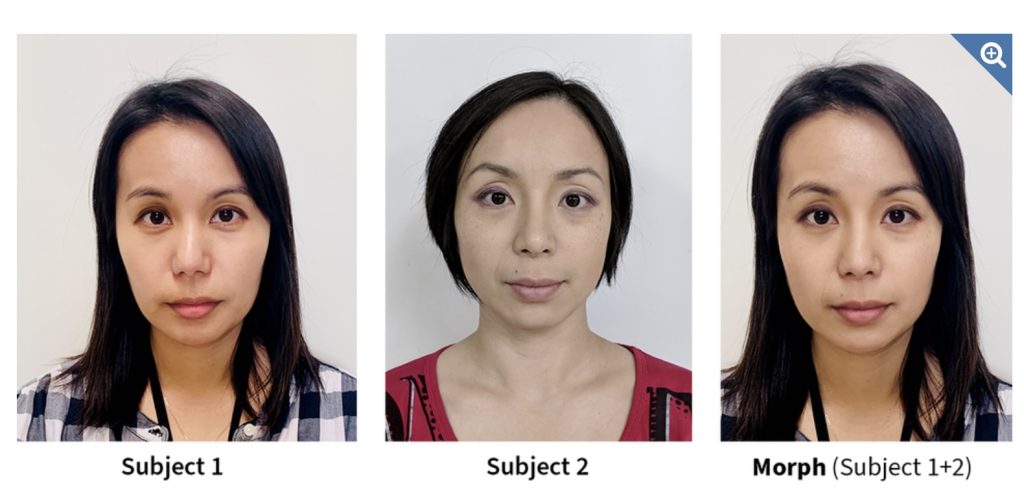A sophisticated new form of identity fraud is quietly eroding security systems worldwide, and most organizations are unprepared. Known as face photo morphing, it digitally blends two or more individuals’ faces into a single image, These morphs can be easily produced using mobile apps, desktop graphics software, or advanced machine learning tools, posing a serious threat to border control, building access, and any system that relies on photo identification.
The Alarming Reality: One Photo, Multiple Identities
Face morphing creates a deceptively simple but devastating vulnerability. When successful, a single morphed passport photo allows both individuals to use the same identity document. At border crossings, both people can present the same passport and pass inspection, whether reviewed by human officers or automated face recognition systems.
This isn’t theoretical. Real-world cases have already been documented, and the threat is escalating as morphing tools become increasingly accessible through smartphone apps, desktop software, and AI-powered platforms.

Face morphing software blends photos of different individuals into a single synthesized image that can deceive identity verification systems.
Credit: National Institute of Standards and Technology (NIST)
Organizations at Primary Risk
Government and Border Security
- Immigration and customs agencies: Multiple individuals crossing borders with one passport
- Passport and ID issuing offices: Fraudulent applications creating “genuine” documents that are difficult to detect
- National security agencies: Unauthorized access to classified facilities or information
High-Security Corporate Environments
- Defense contractors: Unauthorized facility access compromising sensitive projects
- Financial institutions: Infiltration of secure trading floors or data centers
- Critical infrastructure operators: Potential compromise of power plants, telecommunications, or transportation hubs
- Pharmaceutical and research facilities: Access to proprietary research or controlled substances
Industries with Regulatory Requirements
- Government contractors requiring security clearances
- Healthcare systems handling sensitive patient data
- Legal firms with confidential client information
How Morphing Exploits Human and Machine Perception
The attack succeeds because morphed images exploit a fundamental weakness in how we process faces. When security personnel see a morph alongside a person claiming to be that individual, the resemblance appears legitimate. Face recognition systems make the same mistake, calculating high similarity scores between the morph and either original person.
Modern morphing tools can produce images so sophisticated that visible artifacts, inconsistent skin texture, unnatural features around eyes and lips may be completely absent or easily edited out.
NIST’s Detection Framework: Two Critical Approaches
The National Institute of Standards and Technology has released comprehensive guidelines identifying two primary detection methods:
Single-Image Detection (S-MAD): Analyzes suspicious photos for morphing artifacts. Highly effective (up to 100% accuracy) when trained on familiar morphing software, but accuracy plummets below 40% against unknown tools.
Differential Detection (D-MAD): Compares suspicious photos against known genuine images. More consistent across different morphing methods, with 72-90% accuracy, but requires additional genuine photos for comparison.
Implementation Strategy for At-Risk Organizations
Prevention-First Approach
- Attended live enrollment: In-person photo capture by trained personnel
- Trusted capture systems: Cryptographically protected equipment
- Multi-factor authentication: Combine photo ID with additional biometrics
Detection and Response
- Set conservative detection thresholds to maximize morph detection
- Implement investigation procedures: visual inspection, metadata analysis, biometric comparison
- Deploy backup verification methods for flagged cases
The Evolving Threat Landscape
Detection algorithms continue improving but so do morphing tools. What once required specialized knowledge can now be accomplished with consumer smartphone apps. However, the threat remains concentrated among high-value targets where the effort-to-reward ratio justifies sophisticated attacks.
Organizations handling sensitive information, controlling access to critical infrastructure, or managing high-security environments face the greatest risk and should prioritize countermeasures.
Targeted Response Strategy
Face photo morphing represents an active threat to specific high-security sectors. Organizations in these categories cannot afford to wait for attacks to occur before implementing countermeasures. As NIST researcher Mei Ngan emphasizes: “The most effective way is to not allow users the opportunity to submit a manipulated photo for an ID credential in the first place.”
For high-risk organizations, the question isn’t whether you’ll encounter morphing attacks – it’s whether you’ll detect them when they happen. With documented cases in border security and critical infrastructure, affected sectors must act proactively.
For standard commercial organizations using basic photo verification (such as account signup verification), the risk remains low as attackers typically target higher-value opportunities that justify the effort required for sophisticated morphing attacks.
Modern morph detection algorithms offer effective defense capabilities for organizations that need them, but implementation should be proportional to actual risk levels and the value of assets being protected.
NIST’s complete guidelines (NISTIR 8584) provide detailed implementation specifications for organizations ready to deploy morph detection capabilities.